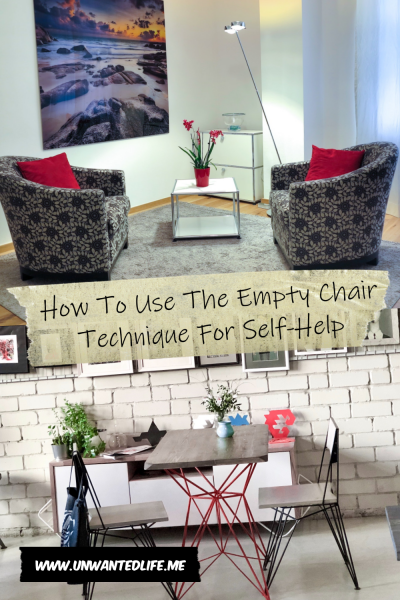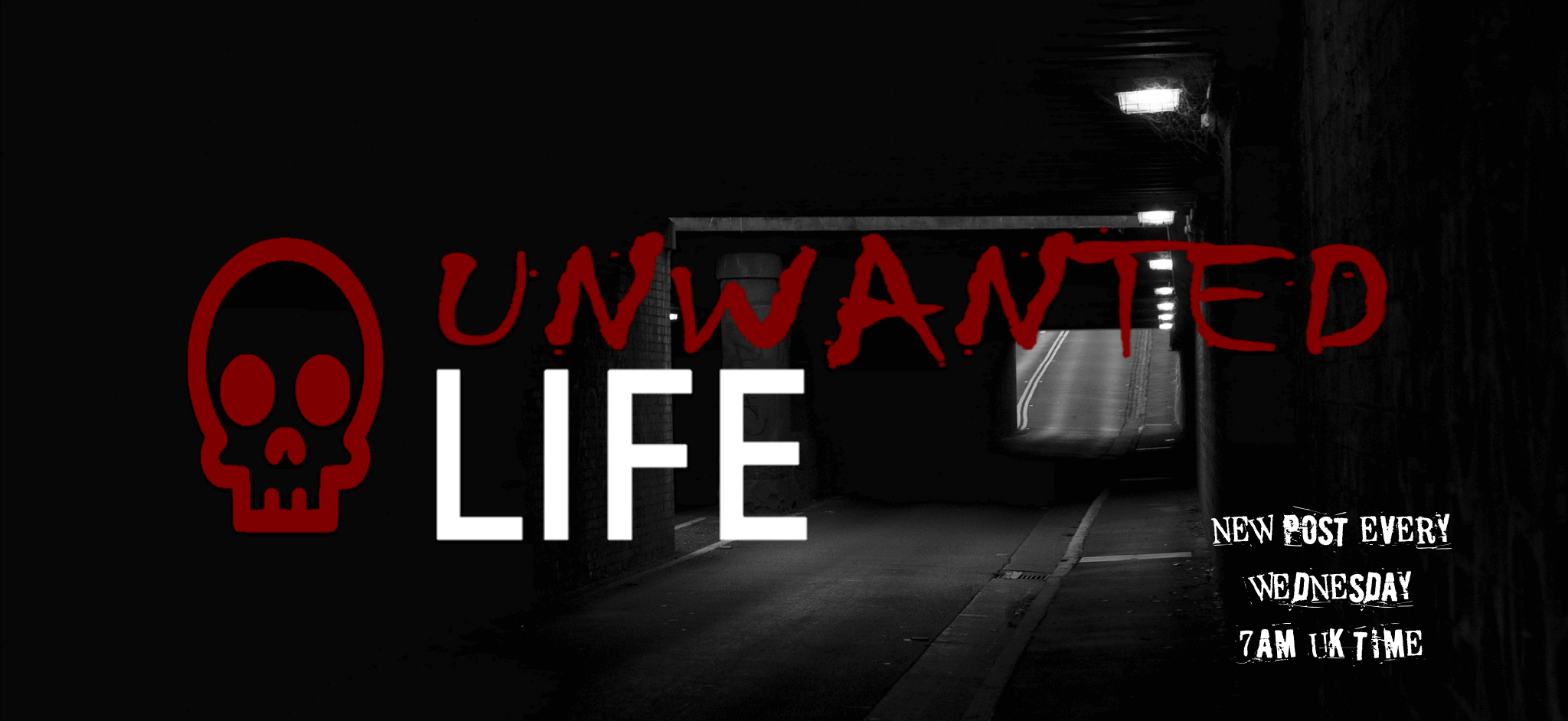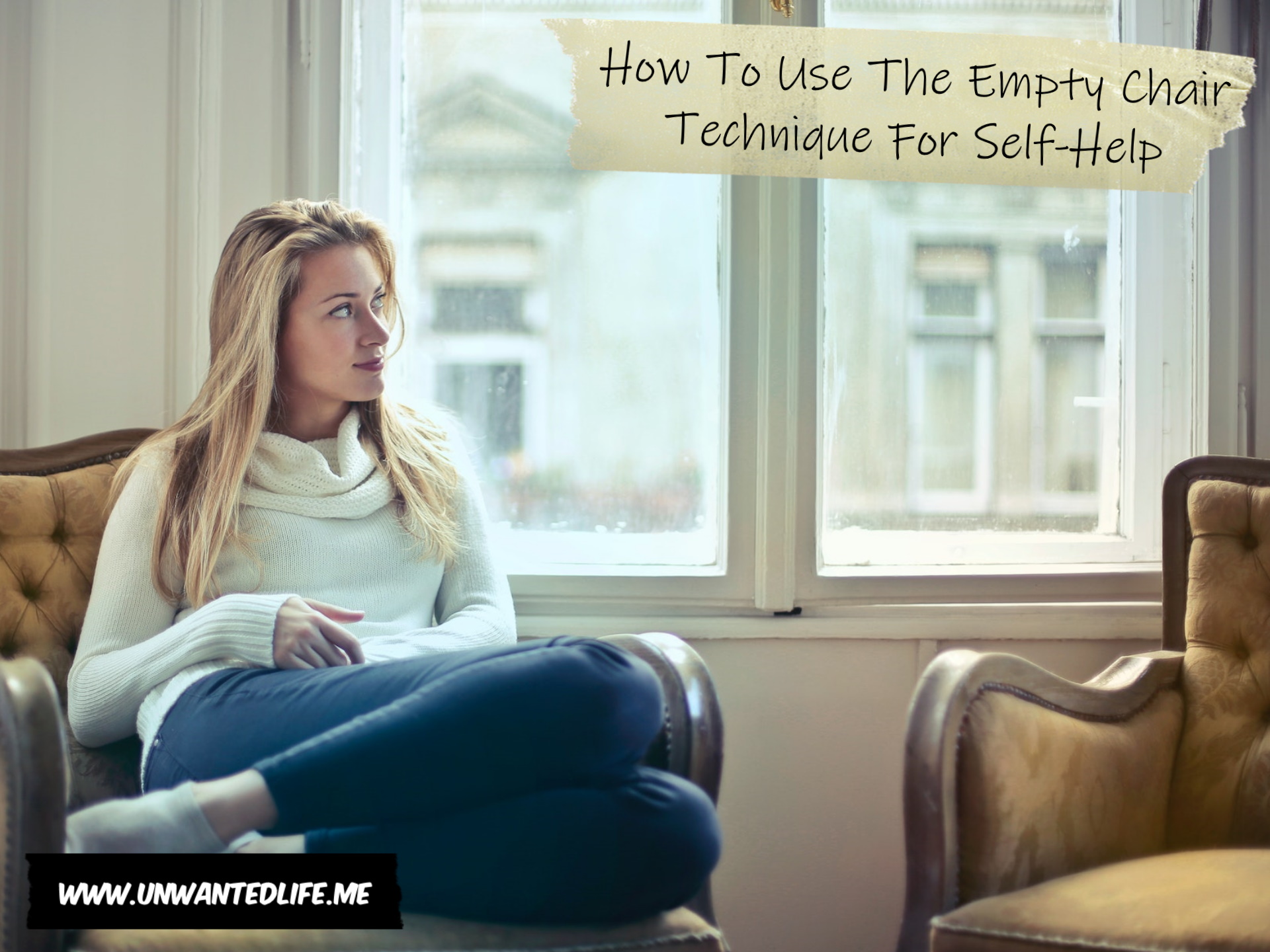I decided to write about Gestalt Therapy’s empty chair technique because I wanted to learn more about it myself, as I’m a multimodal therapist. Rather than being someone who specialises in a single type of therapy style, such as cognitive behavioural therapy (CBT). I’m all for picking what works from other therapy domains so I can provide people with support tailored to their needs. So I hope you find this as educational as I do.
What Is Gestalt Therapy’s Empty Chair Technique
As the name suggests, this technique comes from gestalt theory. This theory emphasises that the whole of anything is greater than its parts, therefore, you can’t analyse things in isolation (Britannica). A good example of this is how I have borderline personality disorder (BPD), eating disorder, body dysmorphic disorder (BDD), social anxiety disorder, and agoraphobia, with the latter two causing psychosis. To look at these as separate and individual issues could mean you’re never able to improve a person’s quality of life because all of it is linked.
This gestalt therapy technique is used by allowing a client to enter into a dialogue with a part of themselves or some significant person that’ll be sitting in an empty chair during a session (APA). This technique is more often used to help facilitate clients in integrating different aspects of their personality in order to further psychotherapeutic insight (Psychology Today). However, there are other uses, which is what we’ll discuss in this article.
Using Gestalt Therapy’s Empty Chair Technique For Self-help
Gestalt therapy’s empty chair technique is useful because it helps bring you into the present, allowing you to resolve conflict within yourself (MentalHelp.net). As already stated, gestalt therapy’s empty chair technique can be used to allow someone to imagine they’re talking to someone specific, which can be useful if you can’t or don’t want to talk to this person directly.
Because the empty chair technique can be used this way, it can be great for helping you find closure or to get things off your chest. It can also be used to help recover from a breakup, help process trauma, and help process grief. It allows you to say the stuff you otherwise can’t or don’t want to say to someone face-to-face. We can all benefit from offloading from time to time.
Using grief as an example, we may have lost someone that we wish we could have said something to. I know when my nana died of cancer; I struggled with my lack of grief and I could have benefited from the empty chair technique as a way to resolve my inner turmoil. By using the empty chair technique, you can imagine talking to the person you’ve lost so you can say what you need to say and get that closure. I wanted to apologise for not being upset at her funeral, as I have an unusual relationship with death because of my history.
In many ways, it’s like the Inner Demons I talked about in an earlier article, whereby you can use a little needle-felted demon to offload to. Accept instead of holding an embodiment of your issues in cute felt form, you use an empty chair.

A quantitative study by Trijayanti, Nurihsan, and Hafina (2019) found, using 16 participants, that an intervention using gestalt therapy’s empty chair techniques could help reduce guilt. Tackling feelings like this can also help with reducing people-pleasing and feelings of imposter syndrome.
Another study by Avsar and Sevim (2022) also found the empty chair technique useful for helping people with social anxiety disorder. They found that this technique allowed people to express their thoughts and emotions through having imagined conversations with people they’d experienced issues with.
Taking a breakup as another example, people often need support to recover from a relationship ending. However, we don’t always have the time or the money to get the support we need. One of the key issues with breakups is how we can still lack closure because of questions left unanswered. Questions like, why don’t they love me anymore? What Did I do wrong?
However, contacting your former partner might not be the ideal step to get that closure, especially if they’ve been abusive to you or are ignoring you. Therefore, using the empty chair technique can help you get that closure, by allowing you to work through your feeling in a safe and healthy way (Better Help). Having that distance while you work through this can be a lifesaver if there is a history of abuse. Plus, having an empty chair to vent at can be a good way to let go and move on.
The Steps
Step 1
Either on your own or with a therapist, work out who or what you’d like to identify and speak to in the empty chair (PsychCentral). Is it a person you’d like to talk to? Maybe it’s your own self-doubt, or maybe it’s something else?
Step 2
Sit in a chair that’s facing an empty chair.
Step 3
Talk to the person or the aspect of yourself that you’re imagining being in the empty chair as if they existed in that chair. There is a modification that can be added to this, which borrows from the two-chair technique.
This is where you switch places with the person or aspect of yourself so you can take on that role and reply to what you’ve said (Haven Foundation). This is particularly helpful when it’s an aspect of yourself. It allows you to explore what’s bothering you in more detail and keeps the conversation energised.
Step 4
After you’ve completed the session either with a therapist or on your own, allow yourself to debrief. This can be done by talking to your therapist about the experience or journaling about it.
Summary
Gestalt therapy’s empty chair technique is a simple idea that has a lot in common with writing a journal. However, when writing a journal it’s a very singular experience, which can be slowed down by your ability to write fast enough. Don’t get me wrong, having our thoughts slowed down through the act of journaling is very useful when it comes to managing our thoughts.
However, there are times when speaking aloud is a better option, because it offers a more personal connection to what, or who, we’re talking to, which you don’t get from writing it down. Thus, allowing for a more natural experience when we want to say something to an imagined person. It also has the benefit of helping us engage in a conversation.
So why not give it a go?
As always, leave your feedback in the comments section below. Also, please share your experiences with using the empty chair technique in the comments section below as well. Don’t forget, if you want to stay up-to-date with my blog, then sign up for my newsletter below. Alternatively, get push notifications for new articles by clicking the red bell icon in the bottom right corner.
Lastly, if you’d like to support my blog, you can make a donation of any size below. Until next time, Unwanted Life readers.
References
Avsar, V., & Sevim, S. A. (2022). The Effectiveness of Cognitive Behavioral Therapy Including Updating the Early Life Experiences and Images with the Empty Chair Technique on Social Anxiety. International Journal of Assessment Tools in Education, 9(1), 181-202. Retrieved from https://dergipark.org.tr/en/download/article-file/2211152 and https://dergipark.org.tr/en/pub/ijate/issue/68288/1062613.
Trijayanti, Y. W., Nurihsan, J., & Hafina, A. (2019). Gestalt counseling with empty chair technique to reduce guilt among adolescents at risk. Islamic Guidance and Counseling Journal, 2(1), 1-10. Retrieved from https://journal.iaimnumetrolampung.ac.id/index.php/igcj/article/view/302/351 and https://journal.iaimnumetrolampung.ac.id/index.php/igcj/article/view/302.


I had not heard of this technique until reading this but it sounds like a great self help tool to have and try out; thank you for writing about this!
I hope it proves a useful tool in your minds toolbox
I have heard of Gestalt Theory before but not this specific technique, however it sounds very cathartic. I have kind of done my own version to process trauma/emotions with a large seal cushion, and I honestly found that helped so much! I would sometimes debrief afterwards with a journal as well.
Thank you for sharing your experience
This is super helpful! I have actually used this in situations like you said where you don’t get the closure you need and I absolutely found that I needed to be able to articulate things and say things out loud.. Thanks for sharing this!
Thank you for sharing your experience. Sometimes you just need to say things aloud
I’m familiar with this technique and may use it – I’ve had a rough few weeks and a terrible experience last week, so could use it
I hope you find it helpful
I have never used this before but it seem helpful. Love that you explained it well for people to understand more about it. Thank you for sharing!
Thanks for commenting
i remember learning about the gestalt theory in college & i always thought of it to be a very therapeutic & cathartic method of handling held traumas or situations.
Thanks for commenting
Fascinating technique! It also makes tremendous sense. That you so much for sharing! ✌️
Thank you for commenting
I enjoy reading your blog posts because I always learn new things. I have not heard of the gestalt theory, but it sounds really helpful. And like something I can try out. This post is very helpful.
Thanks for commenting
Interesting! I hadn’t heard of this technique before. You did a great job of laying out how this would be helpful, particularly switching places into the other chair and imagining responses. It seems like it would be a good exercise into empathy.
I hadn’t thought about how it could.be applied to help increase empathy. Great call
Never heard of this but it sounds a useful technique.
Thanks for commenting
Thank you for sharing. I’ve not heard of the empty chair technique before, but it sounds like it could be a potentially very helpful method.
I think it should be
Such a great technique. But I’ve never heard of it before! In the past, therapists have asked me “what would you say to that person if you could”. And I guess this is a much more imaginative and impactful way to process those feelings.
Certainly sounds like they’ve implemented a version of this technique in their sessions
This is a really interesting technique, I’ve never heard of it before. It’s great because it’s a technique that anybody can use
Indeed it is
Never heard of this empty chair technique before but it sounds a useful technique. It seems like it would be a good exercise into empathy. Thanks for sharing.
Thanks for commenting
Gestalt therapy and the Empty Chair technique sounds very interesting. I’ve had many internal conversations with myself and with others. Sometimes they tend to drag on a bit too much though. That’s why I like the technique and steps you mention. Especially the debriefing part. I’ll see if I can give this a go on my own.
It’s also interesting that you mentioned CBT, because it shown that it is largely based on Stoicism.
Great article as always.
Thanks for sharing
This Empty chair technique sounds interesting and I love the background information you give, including steps on how to perform this therapy on yourself. This kind of structure is what I can use with my frequent inner dialogue when I feel stuck between answers. Thanks
Thanks for commenting
Thank you for sharing. I’ve not heard of the empty chair technique before, but it sounds like it could be a potentially very helpful method.
I think it does too
I haven’t heard of the empty chair technique, but it seems like it could be useful to help process your feelings and provide closure. It does seem similiar to writing down your thoughts, but as you mentioned, it can be better to talk aloud.
Thanks for commenting
The empty chair technique is just awesome and totally new to me as well. I will definitely give it a try. Thanks for such informative post.
I hope you find it beneficial
It appears that I have not previously utilized this particular thing, but based on my initial impression, it seems like it could be quite useful. I wanted to express my gratitude for the thorough and clear explanation that was provided, as it has allowed me to gain a better understanding of how to use it effectively.
Thanks for commenting
Never heard of this empty chair technique before but it sounds a useful technique. It seems like it would be a good exercise into empathy. Thanks for sharing.
Great information about empty chair technique. It really improves my knowledge about self help. A proper mental growth is necessary to manage the daily stress. I prefer to cuddle my dog everyday for my mental peace.
Pets do play an important role in our mental wellbeing. Thanks for commenting